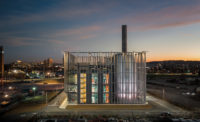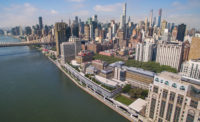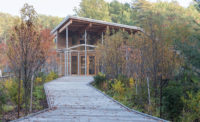The new Smith Campus Center at Harvard University is a building that, like a lot of good architecture, can be read in different ways. You can say Smith is a story about concrete and how we love it, hate it, and sometimes restore it to health when it’s old and sick. Or you can say Smith is a very different story about a university shaping architecture to push a social agenda.
Additional Content:
Jump to credits & specifications
First, though, a quick description. The Smith Center is a mishmash of two periods of construction. The earlier work dates from the 1960s, when Harvard built a 10-story, H-shaped building, the Holyoke Center, to house university offices and services. The Holyoke’s architect was Josep Lluis Sert, a future AIA Gold Medalist known for his love of raw concrete, who was then the dean of Harvard’s Graduate School of Design.
That old Holyoke, now renamed the Richard A. and Susan F. Smith Campus Center, after its primary donors, still has its original 10 floors. But the bottom three or four of those floors (it depends how you count) have been imaginatively reconfigured by London-based Hopkins Architects, with local firm Bruner/Cott as executive architect. Those floors, now the heart of the Smith, have been radically revamped, but not in a way that trivializes the original. Most of the old Holyoke facades, at these levels, are replaced by glazing, the goal being to open better views from the Smith out to the city and from the city back into the Smith. The new glass surfaces can play visual games. Some appear to push in or out like drawers.
So what exactly is the Smith Campus Center? Harvard is quick to note that it isn’t just a student center. The Smith is conceived as the school’s private version of a public downtown, with places to sit, have coffee, or study. It’s meant for everyone, not only for people affiliated with the university. The doors are open to all, and we’re promised that they’ll stay that way. Ideally located, it’s just across the street from historic Harvard Yard and from Harvard Square, with its transit connections.
The Smith is seen too as a flagstaff for strangers, a point of orientation. Tourists, parents, and prospective students used to arrive, look around, and ask “Where is Harvard?” Smith is supposed to give the university a visible front door.
“Social engineering” has been a no-no term in architecture for decades. But the Smith has to be understood as the embodiment of such a concept, as well as the incarnation—in concrete, glass, and steel—of one initiative of Harvard’s former president, Drew Faust. When Faust became president in 2007, one of her first moves was to scatter lawn chairs on the grass of Harvard Yard. The aim was to entice casual strollers to leave paths and strike up a conversation with someone from another discipline or with a different set of interests. The chairs evolved into what the university calls its “common spaces” program, a series of moves to fight the isolation experienced by many people in a big institution.
At the Smith, the goal is much the same: to pull people out of single-purpose places—dorms, labs, private clubs, and classrooms—and encourage them to explore and interact. It is seen as a sort of mixing chamber where town and gown will encounter one another and, hopefully, meet, mix, eat, shop, and exchange ideas. The Smith tempts visitors by seeding itself to satisfy many needs, with food, terraces, performance spaces, part-time offices for literally hundreds of student organizations, and a raft of services such as the Harvard Information Center, with its rich historic collection.
Hopkins has created an interior that explodes in three dimensions, a kind of flying squad of linked public spaces of different levels and sizes. They’re a far cry from the pancake stack of office floors they replace, though key features of the original are retained, such as the handsome north–south arcade, newly bathed in sunlight.
Harvard refers to the new common spaces as living rooms. In Smith, they’re finished in warm-toned European beech. In some places brick floors bring Cambridge indoors. Here and there, lush greenery grows on the partitions, making wandering through the Smith feel like a stroll through a terraced urban garden.
These gathering spaces, the heart of the Smith, come without any particular program of activities. They can be used for anything from a study nook to a holiday ball. One space is shaped as a theater in case anyone wants to use it as one. I’m told a choral singing group takes it over at lunchtime. If you want to reserve a site for a social or educational event, you just go online to the Office of Common Spaces (a name I hope was proposed by Monty Python, but possibly I’m dating myself).
Extending vertically, a small room planted with trees has four walls of transparent glass, but no door. This “vitrine” allows you to sit comfortably in your chair while watching the weather change. As noted, Sert was an admirer of concrete architecture, especially that of his mentor, the Swiss/French Le Corbusier, whom Sert brought to Harvard to design an art-studio building called the Carpenter Center. That bit of history is one more factor that influenced the design of the Smith. Everyone involved, including local preservation advocates, was determined to treat Sert’s surviving work with respect. The building isn’t individually landmarked, but it belongs to a larger conservation district, and the renovation underwent a year or so of public hearings before gaining approval.
The Smith was no picnic as a feat of reconstruction. Deep down, footings were rebuilt to bear the weight of the long spans for the new, larger spaces. At exterior concrete surfaces, engineers probed like surgeons to discover and repair numerous hidden faults in the old steel reinforcing. New interior partitions had to be placed where they wouldn’t conflict with the concrete skeleton. The result is some dramatic collisions of time and place. Original raw, board-formed concrete piers, for example, now stand as massive sculptural presences in the otherwise new steel-framed interiors.
The commons program began with the placement of a few lawn chairs. A dozen years later, that modest initiative has evolved, at the Smith, into a rethinking of the relationship of the university with the community. This is architecture in service to social goals. That’s something not so often seen today.
CreditsArchitect: Hopkins Architects, 27 Broadley Terrace, London, NW1 6LG, United Kingdom. Tel +44 207 724 1751 www.hopkins.co.uk
Personnel in architect's firm who should receive special credit: Andrew Barnett, Mike Taylor, senior partners; Sophy Twohig, Tom Jenkins, Pam Bate, partners; Edward Farndale, Maggie Lo, Yosuke Nagumo, project architects; Jessica Bailey, Heechan Park, architects; Henry Thorold, Rozita Rahman, Bart Chechlowski , Yoonjin Kim, assistants
Executive Architect: Bruner/Cott Architects, 225 Friend Street, Suite 701, Boston, MA 02114 Tel +1 617.492.8400 www.brunercott.com
Personnel: Jason Jewhurst, principal-in-charge; Leland Cott, senior principal; Henry Moss, Lawrence Cheng, principals; Ken Guditz, Karen Greene, Nurit Zuker, Lena Kozloski, Susan Morgan, associates; Christopher Nielson, Kathryn Bilgen, LeeAnn Suen
Interior designer: Hopkins Architects
Engineers: Structural: ARUP M&E: ARUP Lighting and Acoustics: ARUP
Personnel: Tim McCaul, Principal in Charge
Consultants: Landscape: Michael Van Valkenburgh Associates
Personnel: Michael Van Valkenburgh – President and CEO, Emily Mueller De Celis – Associate Principal Cost: Faithful & Gould
General contractor: Consigli
Photographer: Janie Airey, Nic Lehoux |
SpecificationsStructural System Manufacturer of any structural components unique to this project: Macalloy tension rod hanging system
Exterior Cladding ACM Panels: Alcoa Architectural Products Foam Panels: Centria Dimension Series, Centria Metal Wrap Steel Curtainwall: Roschmann Steel and Glass Constructions, Inc. PL-5700 Exterior Louvers: Construction Specialties Group Exterior Deck Tiles: Thermal Ash by Thermory USA
Roofing Membrane Roofing: Sarnafil Green Roof Assembly: American Hydrotech
Windows Custom curtain walling by Roschmann
Glazing Glass Floor System: Greenlight Glass Systems Insulated Glass Units: Saint-Gobain Interior Glass: Cristacurva / Oldcastle BuildingEnvelope
Doors Entrances: CR Laurence Metal doors: Apex Industries Sliding doors: Keller Minimal Windows
Hardware Locksets: Schlage Closers: LCN Exit devices: Von Duprin/Blumcraft Pulls: Ives
Interior Finishes Metal Wall Systems: Gordon, Inc. Claro Acoustically Transparent Panels: Decoustics Rockfon Island Ceiling Cloud Panels: Rockfon Starsilent Acoustical Plaster: Pyrok Suspension Grid: Armstrong Cabinetwork and custom woodwork: Millwork One Paints and stains: Sherwin Williams/Tnemec Cross Piece Grille Linear Wood Ceiling Panels: 9Wood Plastic laminate: Wilsonart Solid surfacing: Dupont Corian Stone: Crème Ole Marble Stone: Alcove Bluestone Daltile, Custom Color Noraplan Sentica Rubber Sheet Flooring: Nora Systems New Stratford in Broadloom and Tile Carpet, Fly Ash Removed: Bentley Raised flooring: Tate Access Floors Vertical Gardens (Green Walls): Plant Wall Design and Vertical Gardens Technology, Installation by Brightview Modular Brick Pavers: Endicott
Furnishings Office furniture: Arper, Herman Miller, Howe, Knoll, Vitra Reception furniture: Arper, B&B Italia, Paola Lenti, Knoll, Vitra, Living Divani Fixed seating: Bespoke Chairs: Arper, Artifort, B&B Italia, Knoll, Herman Miller, Vitra, Bernhardt Design, High Tower, Howe, Magis, New Works, Softline, OOKKUU Tables: Andreu World, Arper, Herman Miller, Howe Upholstery: Kvardrat / Maharam, Paola Lenti, UltraLeather Other furniture: Café furniture: Herman Miller, Kettal, Knoll External Furniture: Kettal, Magis, Tucci
Conveyance Elevators: Otis Custom Vertical Platform Lift: Garaventa USA with Handi-lift
Specialties Expansion Joints: MM Systems Media Wall Design: Local Projects Cementitious Fireproofing: Grace Construction Products Intumescent Fireproofing: Cafco Isolatek International Trees: Elhannon Nursery, Halka Nurseries, Rivendell Nursery Chess Tables: Landscape Forms Inc
Plumbing Equipment Water heaters: PVI and AO Smith Rainwater harvesting equipment: Package provided by Burt Process Equipment Grease Interceptors: Grease Guardian and Zurn Thermostatic mixing valves: Leonard Natural gas booster pumpset: Spencer Turbine Stormwater control valve: ClaVal. Fixtures Lavatories: Duravit chinaware with Sloan faucets WC’s: Kohler with Sloan flushometers Urinals: Sloan waterfree Drinking fountains: Elkay
Energy Energy management or building automation system: Siemens Photovoltaic system: None Other unique products that contribute to sustainability: The use of demand controlled ventilation (L1 & L2 only, where we have the highest occupancies). This saves significant amounts of energy by limiting the amount of fresh air that needs to be conditioned. The rainwater harvesting system which collects storm drainage from the new roof areas together with some existing roofs and stores, treats, and reuses the water for the specific use of irrigating the 8 green walls located in the arcade. The roof collection area and irrigation water demand were carefully balanced to provide the correct amount of water for reuse. |





















Post a comment to this article
Report Abusive Comment